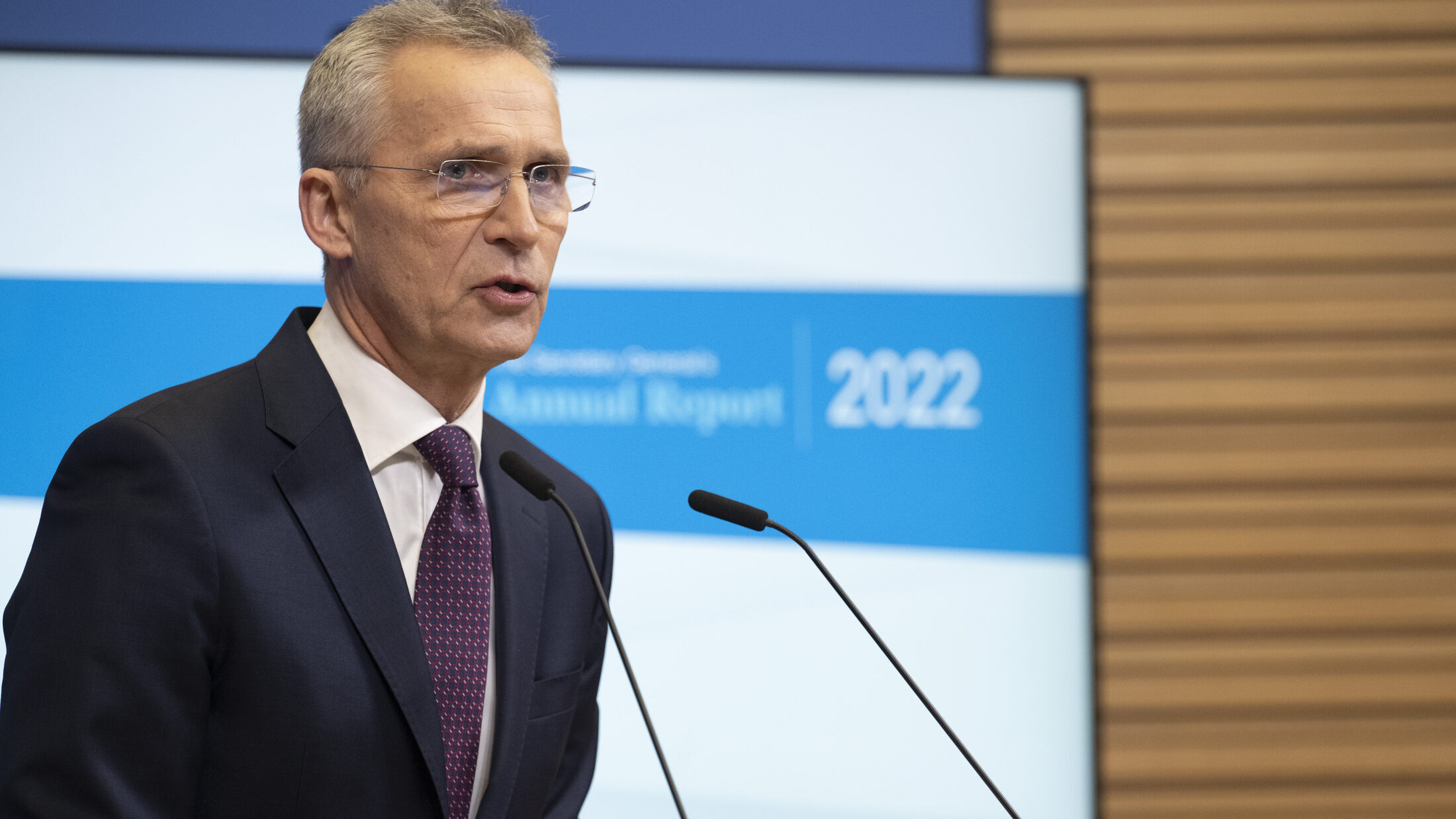
NATO Secretary General Jens Stoltenberg presents the alliance’s annual report for 2022 (NATO)
BELFAST — Just seven of NATO’s 30 member states met its 2 percent GDP defense spending target in 2022, figures from the alliance’s newly published annual report show, while Russia’s invasion of Ukraine highlighted for many the criticality of future defense spending in Europe.
The US, Estonia, Greece, Latvia, Lithuania, Poland and the United Kingdom, all achieved the standard with Croatia and France among those falling just short. Others were further behind.
“We actually expected the number to be slightly higher but because GDP has increased more than expected for a couple of allies, two fell below [the] two percent [target],” said Jens Stoltenberg, NATO Secretary General, addressing media today.
Despite that finding, defense spending across the alliance increased by 2.2 percent in real terms from the year before. Total NATO military spending in 2022 was “estimated to exceed” $1 trillion, figures from the annual report reveal.
The overall 2 percent GDP target is set to be reviewed in July at NATO’s Heads of State Summit in Vilnius, Lithuania. Stoltenberg said that it would be for allies to jointly decide on a new, long-term, spending target but that he will be advocating for an “ambitious” figure.
Despite defense budgets across Europe increasing in response to Russia’s invasion, procurement has not kept pace with “the dangerous world we live in,” according to Stoltenberg, warning that the uplift in military funding must quickly “turn into real cash contracts and concrete equipment.”
He spoke of holding talks with defense industry officials “dedicated to ramping up production” and that NATO will continue to work with different “joint procurement groups” within the alliance to support production targets.
“The most important thing is that contracts are signed with industry so production can be increased,” he added. “We are already seeing more contracts being signed and we welcome all the different initiatives in different formats for joint procurement, because we think that can help to speed up [production] and also utilize economies of scale.”
NATO members have so far delivered €65 billion ($70 billion) worth of military equipment to Ukraine, but disjointed campaigns to send main battle tanks and fighter jets to the frontline, marred by political disagreements, have exposed tension within the alliance. Meanwhile, a bitter dispute between Sweden and Turkey threatens to delay the Scandinavian country’s entry to the organization.
Finland’s path to joining the alliance now looks straightforward, with Hungary to hold a vote ratifying ascension on March 27. Turkey will do the same before its parliament enters recess 1 July, according to Stoltenberg.
He declined to provide an exact date of when Sweden will join NATO but said he had spoken to Turkish President Recep Tayyip Erdoğan on Friday about ratification, but without a timeframe for a parliamentary vote to take place in Turkey, a delay to entry looms.
As international attention turned this week to events in Moscow with the state visit of China’s President Xi Jinping and the Beijing-offered peace plan to resolve the conflict in Ukraine, Stoltenberg said that it is “for Ukraine to decide” the terms of peace. China, he said, must first enter dialogue with Kyiv for Beijing to help broker any kind of peace.
Stoltenberg also said that NATO also has “no proof” that China transferred “lethal” equipment to Russia for the war in Ukraine, but it has “seen some signs” of a request made by Moscow to Beijing for weapons to be made available. The request “is being considered by Chinese authorities,” he added. The comment comes on the heals of media reporting that US intelligence believed China was considering providing lethal aid to Moscow, as well as a report by The New York Times that China had supplied $12 million-worth of drones already.
Elsewhere in NATO’s annual report, the alliance noted a number of key targets were achieved in 2022, including 15 allies supporting the Ground-Based Air Defence program, agreeing to merge it with the Rapidly Deployable Mobile Counter Rockets, Artillery and Mortar project. The land-based initiative seeks to “develop and procure counter rockets, artillery, and mortar capabilities that are mobile and can be rapidly deployed to protect troops and at-risk installations,” noted the annual report.
An “important milestone” was also met in June 2022 after six partners working on the Next Generation Rotorcraft Capability program signed a Memorandum of Understanding to work on studies for the final design of the future medium-sized, multi-role helicopter. The program’s concept phase is expected to run until the end of 2025, with a target of 2040 for entry to service.
In March 2022, a first Multinational Ammunition Warehousing Initiative location was also opened in Estonia to support eight recently established multinational battlegroups. The initiative has been fundamentally designed to “transform the Alliance’s approach to ammunition storage and life cycle management.”
NATO also took delivery of two Airbus A330 Multinational Multi Role Tanker Transport (MRTT) aircraft last year, with a full fleet of nine planes planned for delivery in 2024.
At a maritime level, the Naval Electromagnetic Operations Trial, hosted by Spain at Rota Naval Base in November 2022, saw 45 military assets “from warships to fighter jets” develop electromagnetic warfare technology and test counter unmanned aerial systems concepts.
Move over FARA: General Atomics pitching new Gray Eagle version for armed scout mission
General Atomics will also showcase its Mojave demonstrator for the first time during the Army Aviation Association of America conference in Denver, a company spokesman said.


























